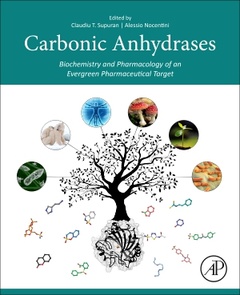Carbonic Anhydrases Biochemistry and Pharmacology of an Evergreen Pharmaceutical Target
Coordonnateurs : Supuran Claudiu T., Nocentini Alessio

Carbonic Anhydrases provides an interdisciplinary review of the burgeoning carbonic anhydrase (CA) research area, spanning from CAs classification (biochemical and structural features) to drug design and pharmacology of CA inhibitors and activators, finally touching on the biotechnological applications of these metalloenzymes. The book adopts a clear step-by-step approach and introduction to this intricate and highly interdisciplinary field. A diverse range of chapters from international experts speak to CA classification and distribution, the mechanisms of action and drug design of inhibitors and activators, the druggability of the various isoforms in the treatment of a multitude of diseases, and threats to human health.
Carbonic Anhydrases provides biology, biochemistry, and medicinal chemistry students and researchers a thorough discussion and update on the evergreen and expanding research area of CAs.
2. a-Carbonic Anhydrases
3. ß-Carbonic Anhydrases
4. ?-Carbonic Anhydrases
5. d-Carbonic Anhydrases
6. ?-Carbonic Anhydrases
7. ? and ?-Carbonic Anhydrases
8. Human Carbonic Anhydrases: Tissue Distribution, Physiological Role and Druggability
9. Mechanisms of Action of Carbonic Anhydrase Inhibitors: Zinc Binders
10. Mechanisms of Action of Carbonic Anhydrase Inhibitors: Compounds That Anchor to The Zinc-Bound Nucleophile
11. Mechanisms of Action of Carbonic Anhydrase Inhibitors: Compounds Occluding the Entrance of The Active Site
12. Mechanisms of Action of Carbonic Anhydrase Inhibitors: Compounds That Bind “Out of The Binding Site And Compounds with An Unknown Mechanism of Action
13. Carbonic Anhydrase Inhibitors as Ophthalmologic Drugs for The Treatment of Glaucoma
14. Carbonic Anhydrase Inhibitors as Diuretics
15. Carbonic Anhydrase Inhibitors for The Treatment of Epilepsy and Obesity
16. Carbonic Anhydrase Inhibitors for The Treatment of Tumors: Therapeutic, Immunologic, And Diagnostic Tools Targeting Isoforms IX And XII
17. Carbonic Anhydrase Inhibitors for The Treatment of Neuropathic Pain and Arthritis
18. Carbonic Anhydrases from Pathogens: Bacterial Cas And Their Inhibitors as Potential Anti-Infectives
19. Carbonic Anhydrases from Pathogens: Fungal Cas And Their Inhibitors as Potential Antifungal Agents
20. Carbonic Anhydrases from Pathogens: Protozoan Cas And Related Inhibitors as Potential Anti-Protozoal Agents
21. Carbonic Anhydrase Activators and Their Potential in The Pharmaceutical Field
22. Biotechnological Applications of Carbonic Anhydrases from Extremophiles
23. CO2 Capture by Engineered Mammalian Carbonic Anhydrases
Active researchers and students in biochemistry, molecular biology, pharmaceutical science, cellular biology, applied microbiology, and biotechnology; medical chemists; clinician scientists
Dr. Alessio Nocentini currently works at the Department of Neuroscience, University of Florence, Italy. He recently concluded his PhD thesis, which dealt with several aspects of carbonic anhydrase, spanning from drug-design, synthesis of inhibitors, and molecular modeling to biological evaluations of carbonic anhydrase modulators. He is now a post-doctoral researcher in Professor Supuran’s research team.
- Offers a full overview of CAs’ biochemical and structural features, as well as drug design and pharmacology of inhibitors and activators
- Provides a thorough update on the newly identified isoforms, modulating chemotypes, and innovative biomedical applications
- Describes the current biotechnological applications of CAs, including processes for CO2 capture
- Features chapter contributions from international leaders in CA biology, medicinal chemistry, and pharmacology
Date de parution : 07-2019
Ouvrage de 560 p.
19x23.3 cm
Mots-clés :
carbonic anhydrase; carbonic anhydrases; carbonic anhydrase distribution; carbonic anhydrase families; a-carbonic anhydrases; ß-carbonic anhydrases; ?-carbonic anhydrases; d-carbonic anhydrases; ?-carbonic anhydrases; ?-carbonic anhydrases; carbonic anhydrases as drug targets; human carbonic anhydrase; tissue distribution; carbonic anhydrase inhibitors; zinc binders; zinc-bound nucleophile; carbonic anhydrase inhibitors; carbonic anhydrase and diuretics; carbonic anhydrase and epilepsy; carbonic anhydrase and obesity; carbonic anhydrase and neuropathic pain; carbonic anhydrase and arthritis; carbonic anhydrases from pathogens; fungal carbonic anhydrases; anti-fungal agents; protozoan carbonic anhydrases; carbonic anhydrase activators; carbonic anhydrases for biotechnological applications; mammalian carbonic anhydrases; carbonic anhydrases from extremophiles



